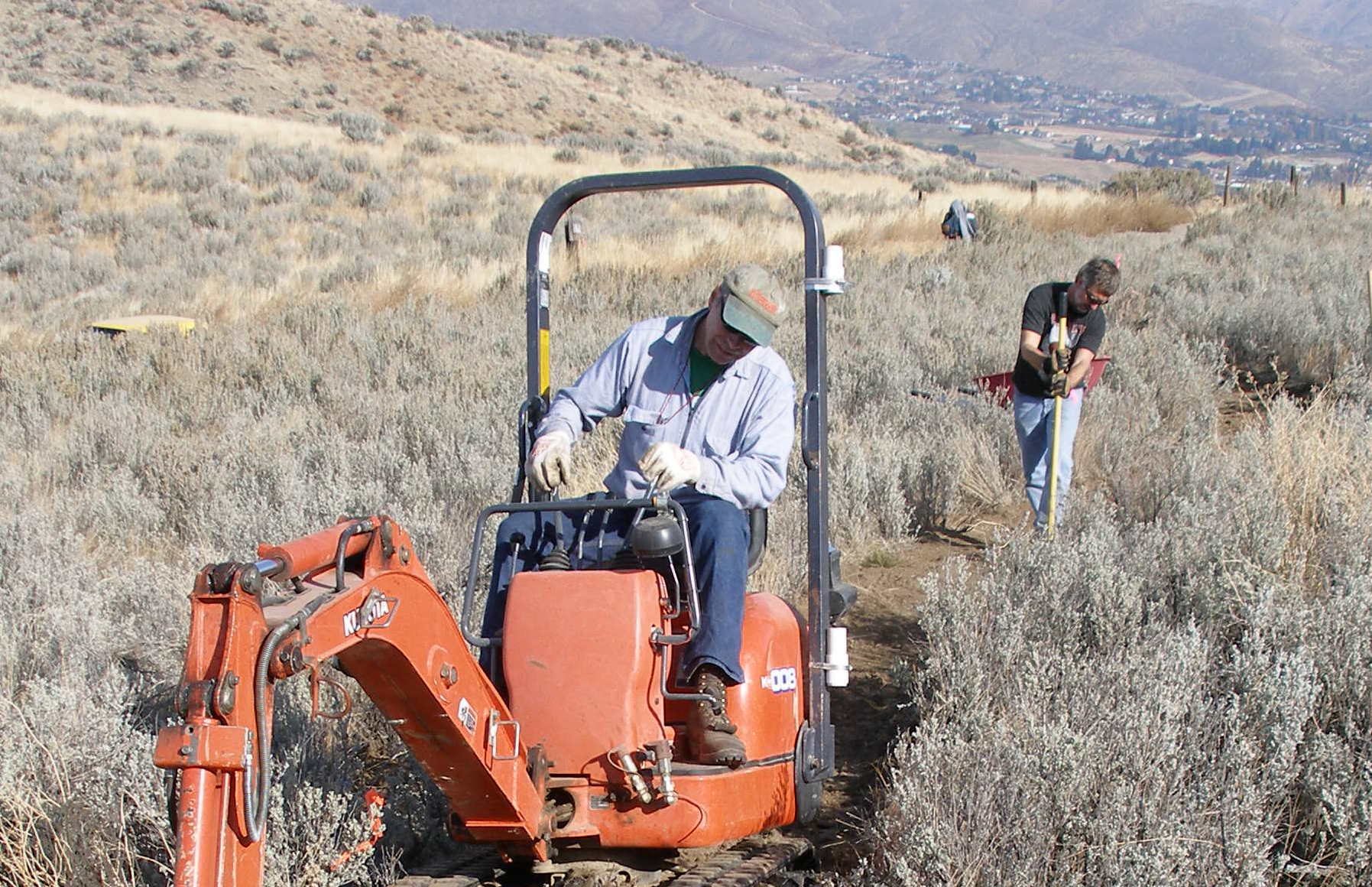by Matt Rose and Andy Dappen
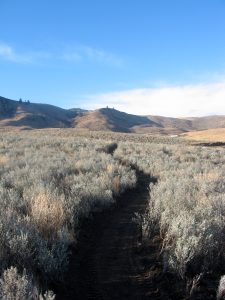
Article in partnership with The Wenatchee World. Forty for Forty: Recognizing the 40th Anniversary of the Chelan-Douglas Land Trust with 40 stories about lands the Land Trust has protected and kept open for public access.
Most of us relate to the tangibility of certain work, say, remodeling a bathroom, painting a bedroom, or planting a garden. In a short amount of time, the product of our efforts is visible and ready to be enjoyed. Such is also the case for trail work – after a few hours of toiling in the dirt, voila, a completely new segment of trail is built or a section of badly eroded trail is repaired. In either case, that trail work is tangible and allows us to return and enjoy a beautiful place. It also gives us joy to see others using something we helped create or repair, and to see them receiving joy or excitement from it.
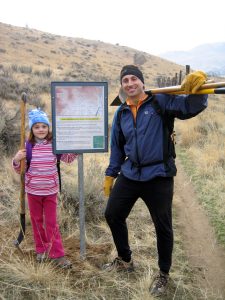
Interestingly, while thousands of people use trails, relatively few understand the ‘whys, wheres, or hows’ of the trails they travel. All trails strive to achieve a number of goals. Besides taking people to a destination, most trails try to entertain its visitors with little surprises, interesting features, or viewpoints along the way. In this respect a great trail is as much about the journey as the destination. Good trails often obscure the road ahead with curves and bends rather than bee-lining so directly to a point that the traveler becomes focused on the far horizon rather than enjoying the details afoot. And a good trail should be built so that it won’t degrade and will require very little maintenance in the years ahead.
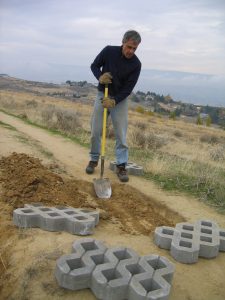
Toward this last point, there are a handful of key design elements in building a low-maintenance trail and these elements are fun to seek out on the trails you walk. Noticing these design features will help you appreciate why the trail was built as it was or so positioned.
The most important design features of a trail focus on the shedding of water from rain storms and melting snow. If the trail itself becomes the water course (i.e., allows water to flow down it), it will erode badly, form ruts, and quickly become unusable. Consequently a trail can’t be too steep or water will choose to run down its tread rather than down the slope the trail occupies. As trails get beyond a certain steepness (much more than 3 percent in our soils), features like water bars, steps or grade reversals are often needed to shed water and keep the path from becoming a stream.
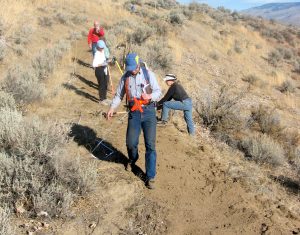
Building trails whenever possible on side slopes (rather than at the bottom of slopes or on flat benches) also keeps water draining off the tread rather than flowing down or pooling on the trail. And once positioned on a side slope, giving the tread a slight outward slant, rather than an inward slant, drains water off the trail and onto the side hill. The details are often small but make huge differences in a trail’s long-term sustainability.
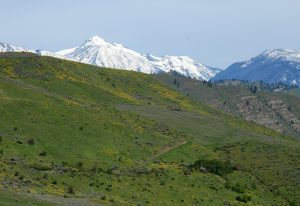
One of our favorite foothills trails that incorporates many of the qualities discussed above is the Glacier View Trail on the Horse Lake Reserve. This winding, two-mile path is an example of taking a walk (or ride) that is about the journey rather than the destination. It’s hard to know where this trail is going, so set aside the impatience of getting somewhere fast and just just enjoy the flow as the trail takes you past spectacular blooms of wildflowers, and to different viewpoints showcasing Burch Mountain, the Wenatchee Valley, Twin Peaks, Butler Ridge, Cashmere Mountain, the Enchantments, and, of course, Glacier Peak.
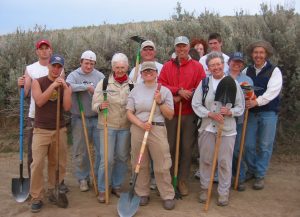
While you wander, pay attention to how this trail was built – how it sheds water by not being too steep, how it cuts across small mounds and slopes providing side hills for drainage, how it disguises where it’s going so walkers don’t get fixated on a destination, how it hides switchbacks so lazy walkers won’t cut between them (a practice that contributes greatly to trail erosion). This is a trail where thoughtful design and a beautiful setting merge into an exceptional experience.
And for those of us who have worked on it, this trail is a tangible product of our labor that we enjoy visiting again and again.
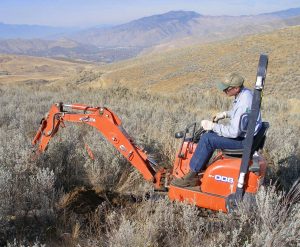
Details: Glacier View Trail
Access. From the north end of Wenatchee, drive Horse Lake Road until the paved road turns to gravel. From here, follow the well-maintained dirt road roughly 2.75 miles uphill until the road is blocked by a gate at the entrance to the Horse Lake Reserve. Park here on the edge of the road, being mindful to leave room for other cars to turn around here.
Trip Instructions. Walk around the gate blocking the road and follow the gravel ranch road for 0.4 miles until it forks
—Take the left fork onto a grassy, double-track road that climbs more steeply. Follow this grassy road (called the Old Ranch Road) as it contours and climbs steadily for two-thirds of a mile (0.66 miles) in what is generally a northwesterly direction. When the road makes a sharp switchback and starts heading south, look for a smaller trail on your right. This is the Glacier View Trail.
—Branch off on the Glacier View Trail and follow it for two miles as it heads north, then west, and then south. After two miles the Glacier View Trail re-intersects the Old Ranch Road you started on, but at a higher point.
—Turn left and follow the Old Ranch Road downhill. In 0.8 miles, you’ll reach the switchback where the Glacier View Trail started. Keep following the Old Ranch Road downhill, retracing the route you walked earlier.
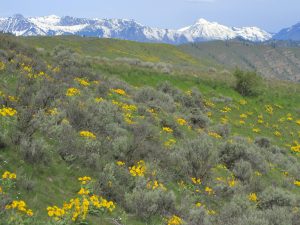
Map. See a map of the Horse Lake Reserve and the Glacier View Trail
Total Distance: 4.75 miles.
Elevation Gain: 800 vertical feet.
Land Ownership. The hike is on property owned and managed by the Chelan-Douglas Land Trust.
Allowed: Hiking, trail running, mountain biking, horseback riding, dogs on leash (scoop their poop).
Not Allowed: No motorized use, no hunting, no shooting, no plant collecting, no camping, no campfires, and no littering.
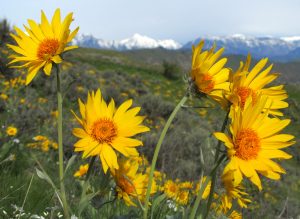
Important. In all of our foothills parcels of land, off-trail travel and use of social trails (faint, user-made trails formed by people leaving the main trails) is prohibited because our soils and plants are easily damaged. Ask yourself, “If I take this route and hundreds of people follow suit, what will the ground look like then?” Getting people not to inflict damage by traveling off-trail is the biggest maintenance issue faced by trail managers.
Events. The Chelan-Douglas Land Trust offers a wide variety of events that connect people to the outdoors—and just as many opportunities to give back. From trail work and planting to fence removal and office support, volunteers play a vital role in everything we do. Explore upcoming events and find ways to get involved at www.cdlandtrust.org/events
Matt Rose is a local trails enthusiast who, as a volunteer and as a hired professional, has built many of the trails we enjoy in the Wenatchee foothills and at Squilchuck State Park.

